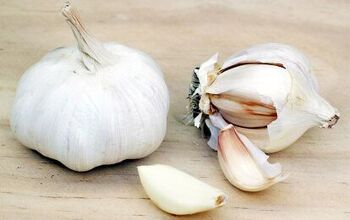Flea Repellent Dog Treat Recipe

Fleas don’t like garlic. Perhaps it’s the aftertaste that repels them. I mean, nobody likes kissing somebody after chowing down on Caesar Salad… am I right? A tablespoon of garlic powder goes a long way in this Flea Repellent Dog Treat Recipe. Garlic has many health benefits for people and dogs, plus it comes with the added bonus of helping to keep fleas away. But this treat isn’t just a flea deterrent – it’s full of yummy and healthy ingredients that make it a wonderful treat anytime.
Garlic For Fleas? Heck Yeah!
Okay, we know. “Don’t give garlic to your dogs,” you’ve probably heard. Here is the thing. Studies showing it to be toxic involved LARGE (we’re talking really large) doses. It’s the thiosulphate in garlic that can damage their liver, but it has to be at a mega dosage to do so.
Garlic is actually a great way to combat fleas. Fleas do NOT like the smell of garlic and if you feed it to your pets, it’s like you’re creating a walking, furry flea repellant. It’s best if it’s fresh, and again, remember, we’re not giving high doses of garlic. We’re giving enough to give some benefit to your doggo and to repel those fleas at the same time.
And guess what? There’s magical power in Brewer’s Yeast we’re putting in these treats. It’s true! Brewer’s Yeast will also help repel fleas (but not ticks, so be careful still) and dogs love the taste as well. It’s like helping their gut and their insect repelling power with one delicious treat.
Flea Repellent Dog Treat Recipe
Makes 30-40 cookies
Ingredients:
3 cubes chicken or beef bouillon
1 cup boiling water
2 1/2 cups whole wheat or all-purpose flour
1 cup cornmeal
2/3 cup brewer’s yeast
1 tablespoon garlic powder
2 eggs
Directions:
- Preheat the oven to 375 degrees F.
- Dissolve bouillon cubes in boiling water and set aside.
- In a large bowl, stir mix flour, cornmeal, brewer’s yeast, and garlic powder. Stir eggs into the mix.
- Gradually pour in the bouillon water while stirring. Mix for a firm dough.
- On a floured surface, roll the dough out to 1/4 inch thickness. Cut using cookie cutters and place on non-stick cookie sheets.
- Bake for 20 minutes. Place on cooling rack and leave overnight to harden.
That’s it! Less than an hour of work and your pooch has a month’s worth of tasty, healthy snacks that will also help keep those pesky parasites at bay (fingers crossed!). We love to see how our recipes turn out for you. Please share your photos on our Facebook page. Or if you made substitutions, let us know in the comment section below.
And if you have any doubts about garlic being used to make these treats, read on to learn more about why this veggie is the star of this recipe.
Useful Information: Garlic and Dogs
If you read garlic in the ingredient list of a dog treat recipe and audibly gasped, you’re not alone. Many pet parents think that garlic is bad for dogs, and the consumption of garlic remains a controversial question: some claim that this plant is toxic to dogs, others laud its beneficial effect on canine’s overall health. So what’s the truth? Like with all things, the key is having a measure in things. You have to be mindful of dosage if you worry about your pet’s safety. Going overboard with garlic is definitely bad for your pooch, and no one is disputing that. But when given in moderation, garlic can be a wonderful addition to your pet’s diet. New research indicates that garlic is not only safe for dogs to eat, but it also has a positive influence on their immune system. The list of benefits includes better cardiovascular health and a healthier liver, as well, so it’s not like the positive effects of feeding garlic to dogs can be dismissed easily.
To sum it all up, the minuscule amount of garlic this recipe calls for (and mind you, the one teaspoon of powdered garlic is distributed in those 30 to 40 treats, not just one) shouldn’t pose a problem for your pooch. If you have any further doubts or concerns, consult your vet for tailored advice that pertains to your pet specifically.
The Effects of Garlic on Fleas
So, why is it garlic that transforms these dog cookies from pawesome to flea-repelling to boot? For some reason, fleas detest the smell and the taste of garlic. Generally, fleas can be repelled by potent scents as this bothers them, but often natural solutions that rely on the scent can bother your pooch too: some dogs dislike the overpowering aroma of lavender, lemongrass, and other repellents in natural dog collars, for instance. This is why these dog treats are such a clever solution: your pet will love munching on these crunchy cookies, but as they contain garlic, his blood will become unpalatable to fleas. It usually takes a few days of regular consumption for this to happen- but then, any flea that tries to munch on your pooch is in for a nasty surprise. Take that, bloodsuckers! Of course, as is usually the case with natural, mild remedies, the trace amount of garlic won’t be enough if your pet has a serious infestation with fleas- this is more of a precaution. In case your pooch is already itching and scratching because of parasites, flea treatment products will be unavoidable.
Other Benefits of Garlic for Dogs
Helping to repel fleas and ticks isn’t the only benefit that garlic has to offer your pup. In fact, including garlic in your dog’s diet will open the door to a wide variety of great benefits to their health and well-being.
If you’re worried about your dog being exposed to a bug or illness in the area, that’s the perfect time to incorporate garlic into your routine. It works to improve the immune system, helping them naturally fight off any illnesses that may come their way. Some research even shows that the allium compounds found in garlic may be able to help fight off some forms of cancer.
In addition to fighting viruses, it can also be helpful in ridding the body of fungal infections or parasites. Garlic contains volatile oils and sulfur compounds, both of which help to rid your dog’s system of internal parasites like tapeworms. If you have a dog that struggles with ear mites, create a topical ointment by combining garlic and olive oil and applying it to their ears. In both cases, garlic shouldn’t be seen as a substitute for medical treatment, but it can be used as a great addition to your treatment plan.
The compounds found in garlic also have a positive impact on your dog’s heart health. Adding garlic to your dog’s diet can help to reduce cholesterol, lower the amount of fat build-up found within the arteries of the heart and prevent the formation of clots in the body.
With so many great benefits emerging, it’s no wonder that the view of garlic for dogs has been quickly changing!

Amy Tokic, Editor of PetGuide.com, is a passionate animal lover and proud pet parent of Oscar, a Shih Tzu/Chihuahua cross, and Zed, a Japanese Chin. Her love of animals began in kindergarten, when she brought her stuffed dog Snoopy into class with her every day. Now, she writes about her adventures in pet ownership and tirelessly researches products, news and health related issues she can share with other animal enthusiasts. In her free time, Amy loves perusing used book and record stores, obsessing over the latest pet products available and chasing squirrels with wild abandon (a habit attributed to spending too much time with her pooches).
More by Amy Tokic























